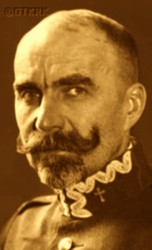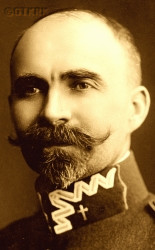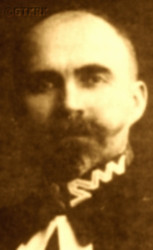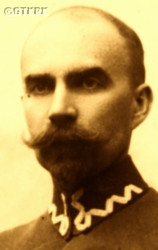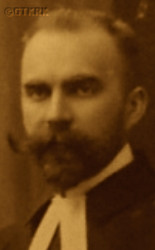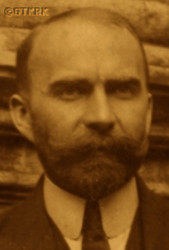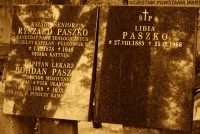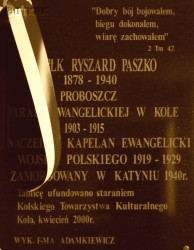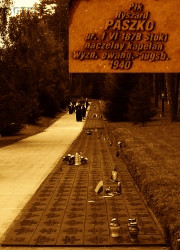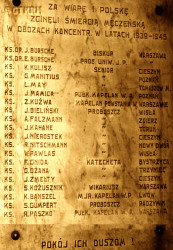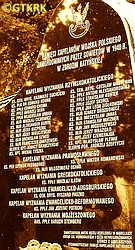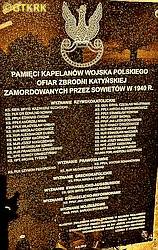Roman Catholic
St Sigismund parish
05-507 Słomczyn
85 Wiślana Str.
Konstancin deanery
Warsaw archdiocese, Poland
full list:
displayClick to display full list

searchClick to search full list by categories
wyświetlKliknij by wyświetlić pełną listę po polsku

szukajKliknij by przeszukać listę wg kategorii po polsku

Martyrology of the clergy — Poland
XX century (1914 – 1989)
personal data
surname
PASZKO
surname
versions/aliases
PASZKE
forename(s)
Richard (pl. Ryszard)
function
pastor
creed
Evangelical Church of the Augsburg Confession in Poland EA
diocese / province
Evangelical Military Pastoral Caremore on
pl.wikipedia.org
[access: 2024.12.13]
academic distinctions
Theology Candidate (i.e. Bachelor)
honorary titles
War Order of Virtuti Militari — Silver (5th Class)more on
en.wikipedia.org
[access: 2019.10.13]
(11.11.1976, Londontoday: London Cou., England, United Kingdom
more on
en.wikipedia.org
[access: 2024.03.19], decree of Stanislav Ostrowski, President of the Republic of Poland in exile)
September Campaign Crossmore on
pl.wikipedia.org
[access: 2023.11.24]
(01.01.1986, Londontoday: London Cou., England, United Kingdom
more on
en.wikipedia.org
[access: 2024.03.19], decision of George Premyslav Morawicz, Minister of Military Affairs of the Polish Government in exile)
„Polonia Restituta” Cross — 4th Class, Officer'smore on
en.wikipedia.org
[access: 2019.04.16]
(31.12.1923)
„Medal of Independence”more on
en.wikipedia.org
[access: 2019.02.02]
(15.06.1932)
Commemorative Medal for War of 1918–21more on
pl.wikipedia.org
[access: 2019.10.13]
Ten Years of Independence Medalmore on
pl.wikipedia.org
[access: 2019.10.13]
Ideology Prisoners Commemorative Badge
(1929)
Cross for Clergy (Russian Empire) — golden
(1913)
date and place
of death
04.1940

NKVD TverHQ at 17 4 Sovetskaya Str
today: Tver Medical Institute, Tver oblast, Russia
more on
en.wikipedia.org
[access: 2021.10.09]
alt. dates and places
of death
15.04.1940 (after)
details of death
During World War I 1914‐1918, after the Russian defeat in the Battle of Gorlice in 05.1915 and the panicky escape of the Russians (the so‐called bezhenstvo), after the beginning of the German occupation, for the Germ. „Deutschfeindlicke Gesinnung” (Eng. „anti‐German sentiment”) and „promoting Polish patriotism” — i.e. a written protest against the beating of the population by the German occupier, and in fact for preaching in sermons that „Poland will be free and independent” —interned on 27.07.1915 by the Germans on the island of Dänholm in the Stralsund Strait of the Baltic Sea, and then from 26.08.1915 in Celle near Hannover. Released on 24.06.1916, without the right to return to his parish in Koło.
Settled in Łomża. There from 1916 to 01.04.1918 a member of the then semi‐legal Polish Military Organization POW. In 1917 was a delegate from Łomża to the national POW congress in Warsaw — perhaps on 29.04.1917 participated in POW exercises in Zielonka n. Warsaw.
In 02.1918, for protesting against the separatist treaty in Brest of 09.03.1918, by virtue of which the Central Powers (the German Empire and the Austro–Hungarian Empire) decided, among other things, on the awarding of the Chełm region to the future Ukrainian state, for „promoting Polishness among school youth and among the faithful of the parish” and „ordering the children to copy Mary Konopnicka's 'Rota'”, which included the words „the German will not spit in our face / and Germanize our children”, suspended in his rights as a clergyman in Łomża. Expelled from Łomża to Łódź, where on 01.04.1918 was placed under police supervision, with the restriction Germ „ohne Reisegenchmigung” (Eng. „without the right to travel”).
After Poland regained independence in 11.1918, volunteered for the Polish Army and was accepted on 25.09.1919.
Participated in Polish–Russian war of 1919‐1921.
After German invasion of Poland on 01.09.1939 (Russians invaded Poland 17 days later) and start of the World War II, on 07.01.1939 left his house in Sulejówek and voluntarily joined an officer–less group of soldiers taking command.
Arrested — after start of Russian occupation — by the Russians in Zamość at the end of 09.1939.
Held in NKVD filtration camp PFL Putivl and next in KLW Kozelsk concentration camp in Kozelsk (according to some sources KLW Starobilsk in Starobilsk).
On 23‐24.12.1939 moved to Butyrki prison in Moscow and in the spring of 1940 to KLW Ostashkov concentration camp in Ostashkov.
From KLW Ostashkov — his name is on the NKVD deportation list No. 027/3 prepared on 13.04.1940, item 33 (case No. 5883), with an order to be placed at the disposal of the head of the NKVD Directorate in Tver — deported prob. in 04.1940 (the date is unknown, but judging by the date of preparation of the deportation list, deportation took place — as in other known cases — shortly thereafter) to the execution site in Tver and murdered.
By Polish Minister of Defence’s decision No. 439/MON of 05.10.2007 posthumously promoted to the rank of brigadier general.
prisoner camp's numbers
5883 (KLW OstashkovClick to display the description)
cause of death
mass murder
perpetrators
Russians
sites and events
NKVD TverClick to display the description, «Katyn genocide 1940»Click to display the description, KLW OstashkovClick to display the description, Moscow (Butyrki)Click to display the description, KLW StarobilskClick to display the description, KLW KozelskClick to display the description, PFL PutivlClick to display the description, Ribbentrop‐MolotovClick to display the description, Polish‐Russian war of 1919‐1921Click to display the description
date and place
of birth
01.06.1878

Stokitoday: Drużbice gm., Bełchatów pov., Łódź voiv., Poland
more on
en.wikipedia.org
[access: 2022.01.28]
parents
PASZKE Adolph Gustav
🞲 ?, ? — 🕆 ?, ?

KÖBERNICK Caroline
🞲 ?, ? — 🕆 ?, ?
presbyter (holy orders)
ordination
24.06.1900

positions held
1929 – 1939
pensioner — Podklasztorzetoday: part of Sulejów, Sulejów gm., Piotrków Trybunalski pov., Łódź voiv., Poland
more on
en.wikipedia.org
[access: 2020.11.05] — retired on 30.09.1929; also: municipal councillor
1919 – 1929
Chaplain in Chief — Warsawtoday: Warsaw city pov., Masovia voiv., Poland
more on
en.wikipedia.org
[access: 2021.10.09] ⋄ Evangelical–Augsburg chaplaincy, Polish Armed Forces — 08.08.1922 promoted to the rank of senior with seniority from 01.06.1919 and 1st place in the military clergy of the Evangelical–Augsburg Confession, i.e. in the rank of colonel; 03.05.1922 verified in the rank of chief chaplain with seniority from 01.06.1919 and 1st place in the military clergy of the Evangelical–Augsburg denomination; 25.09.1919 appointed chief chaplain of the Evangelical–Augsburg Confession; also: head of the Evangelical–Augsburg Confession Department of the Non–Catholic Denominations Office of the Ministry of Military Affairs (1927‐1929), head of the Main Pastoral Office of the Evangelical–Augsburg Confession
1921 – 1929
administrator — Warsawtoday: Warsaw city pov., Masovia voiv., Poland
more on
en.wikipedia.org
[access: 2021.10.09] ⋄ Command of the Corps District DOK No. I Warsaw, Polish Armed Forces ⋄ Ascension of the Lord EA military parish (at 2/4 Puławska Str.) — also: contract teacher of the Evangelical religion at the Thaddeus Reytan' s State Gimnazjum in Warsaw (from 12.1921)
1918 – 1919
minister — Łódźtoday: Łódź city pov., Łódź voiv., Poland
more on
en.wikipedia.org
[access: 2021.07.18] ⋄ EA parish
20.08.1916 – 1918
parish priest — Łomżatoday: Łomża city pov., Podlaskie voiv., Poland
more on
en.wikipedia.org
[access: 2022.01.28] ⋄ EA parish
01.07.1903 – 28.07.1915
parish priest — Kołotoday: Koło urban gm., Koło pov., Greater Poland voiv., Poland
more on
en.wikipedia.org
[access: 2021.12.18] ⋄ EA parish
01.07.1903 – 28.07.1915
administrator — Babiaktoday: Babiak gm., Koło pov., Greater Poland voiv., Poland
more on
en.wikipedia.org
[access: 2021.12.18] ⋄ EA parish
01.01.1902 – 1903
vicar — Tomaszów Mazowieckitoday: Tomaszów Mazowiecki urban gm., Tomaszów Mazowiecki pov., Łódź voiv., Poland
more on
en.wikipedia.org
[access: 2021.09.29] ⋄ Saviour EA parish
24.06.1900 – 1901
vicar — Zgierztoday: Zgierz urban gm., Zgierz pov., Łódź voiv., Poland
more on
en.wikipedia.org
[access: 2021.12.18] ⋄ EA parish
c. 1895 – 1900
student — Dorpattoday: Tartu, Tartu city mun., Tartu cou., Estonia
more on
en.wikipedia.org
[access: 2023.03.24] ⋄ Evangelical Theology Department, University of Dorpat — postgraduate specialised studies, crowned with Theology Candidate degree; also: member of „Polonia Convent” academic corporation
from 1908
married — four children
others related
in death
BANSZELClick to display biography Charles, BIELIŃSKIClick to display biography Joseph, BURSCHEClick to display biography Edmund, BURSCHEClick to display biography Julius, FALZMANNClick to display biography Alexander Charles, FREYDEClick to display biography Alfred, GNIDAClick to display biography Francis, GUMPERTClick to display biography Steven Edward, GUTKNECHTClick to display biography Bruno, GUTSCHClick to display biography Sigismund, HAUSEClick to display biography Paul Henry, KAHANEClick to display biography George, KOŻUSZNIKClick to display biography Stanislav, KULISZClick to display biography Charles, KUŹWAClick to display biography Sigismund, LEHMANNClick to display biography George, MAYClick to display biography Leo Witold, MAMICAClick to display biography Joseph, MANITIUSClick to display biography Gustav, NIEROSTEKClick to display biography Joseph, NITSCHMANNClick to display biography Adam Robert, OŻANAClick to display biography Gustav, PAWLASClick to display biography Vladislav, WAGNERClick to display biography Richard Ernest, ZMEŁTYClick to display biography Adolph, DUBIELClick to display biography Alexander, JANASClick to display biography Mieczyslav, KACPRZAKClick to display biography Joseph, MARCOŃClick to display biography Mieczyslav, MASŁOŃClick to display biography Vladislav, MIKUCZEWSKIClick to display biography Joseph, MIODUSZEWSKIClick to display biography John, NOWAKClick to display biography Edmund, OCHABClick to display biography Vladimir, ROMANOWSKIClick to display biography Victor, SKORELClick to display biography Joseph, SZWEDClick to display biography Bronislav, WOJTYNIAKClick to display biography Ceslav, ZAKRZEWSKIClick to display biography Francis
sites and events
descriptions
NKVD Tver: On 04.04‐22.05.1940 the Russians executed in NKVD HQ building at 4 Sovetskaya Str (now Tver Medical Institute) in Tver c. 6,314 Polish prisoners of war (POW) kept in KLW Ostashkov concentration camp in Ostashkov. This genocide was the implementation of the decision of the Russian Commie‐Nazi authorities — the Politburo of the Russian Commie‐Nazi party — of 05.03.1940 to exterminate tens of thousands of Polish intelligentsia and servicemen, held in Russian camps established after the German‐Russian Ribbentrop‐Molotov Agreement and the annexation of half of Poland by the Russians in 1939, known as «Katyn genocide». After the formal „verdict”, the NKVD Special Council Moscow, i.e. the genocidal Russian kangaroo court known as the «NKVD Troika», sent successive disposition letters to the NKVD in Tver — there were c. 60 of them — containing the names of the persons to be murdered. The prisoners were brought — Tver is c. 190 km from Ostashkov — to the NKVD HQ building, identified one by one in a basement room known as the „Lenin’s room”, handcuffed, taken to another room cellar with a door covered with felt, and then murdered individually by a shot from a German Walther P38 pistol into the back of the head. The bodies where next dumped into mass graves in ditches in the Miednoje forest, in the NKVD summer resort, and covered with sand by an excavator. (more on: pl.wikipedia.orgClick to attempt to display webpage
[access: 2012.11.23], en.wikipedia.orgClick to attempt to display webpage
[access: 2014.05.09])
«Katyn genocide 1940»: 05.03.1940, the Russian Commie‐Nazi authorities — the Politburo of the Russian Commie‐Nazi party headed by Joseph Stalin — made a formal, secret decision No. P13/144 to exterminate tens of thousands of Polish intelligentsia and military personnel, „declared and hopeless enemies of the Russian government”, held in Russian camps, as a consequence of the German‐Russian Ribbentrop‐Molotov Agreement, the invasion of Poland and annexation of half of Poland in 09.1939, and the beginning of World War II. The decision was, as it were, „sanctioned” by the verdicts of the NKVD Special Council, i.e. the genocidal Russian kangaroo court known as «NKVD Troika» in Moscow. The implementation in Ukraine and Belarus was made possible by order No. 00350 of 22.03.1940 of the head of the NKVD, Lavrentiy Beria, on the „unloading of NKVD prisons”, i.e. transfer of prisoners from several prisons in Ukraine and Belarus to central prisons, e.g. in Kiev or Minsk. The genocidal «NKVD Troika», after issuing sentences, also sent to local NKVD units, NKVD disposition lists — i.e. lists of convicts — each containing on average c. 100 names. Named lists are known — may be reconstructed — for people held in the KLW Kozelsk and KLW Ostashkov camps, but not for KLW Starobilsk, known for victims from Ukrainian prisons, but not Belarusian ones. It is not even known exactly how many lists there were, mainly because the number of them sent to the NKVD in Belarus is unknown. On 03.03.1959 Alexander Shelepin, then head of the Russian KGB, in a handwritten note stated: „ Since 1940, the Committee for State Security under the Council of Ministers of Russia, has been keeping records and other materials relating to the prisoners of war and interned officers, gendarmes, policemen, etc., people from former bourgeois Poland shot that year. In total, based on the decision of the special troika of the NKVD of the USSR, 21,857 people were shot, of whom: 4,421 people in the Katyn Forest (Smolensk Oblast), 3,820 people from the Starobilsk camp near Kharkov, 6,311 people from the Ostashkov camp (Kalinin Oblast), and 7,305 people in other camps and prisons in Western Ukraine and Western Belarus. The entire operation of liquidation of the above–mentioned was carried out on the basis of the Resolution of the Central Committee of the CPSU of 05.03.1940”. The head of the NKVD recommended to the Russian leader, Nikita Khrushchev, to destroy all personal files of those shot in 1940, but to keep the minutes of the meetings of the «NKVD Troika» and confirmations of the implementation of the decisions of the «NKVD Troika». A one–sentence draft resolution was attached to the note. It is not known whether the resolution was accepted and whether the files were destroyed. The aforementioned protocols and confirmations of the «NKVD Troika» are also not known. There are indications — i.e. four so‐called „NKVD‐Gestapo Methodical Conferences” of 1939‐1940: in Brest on Bug, Przemyśl, Zakopane and Cracow — of close collaboration between Germans and Russians in realization of plans of total extermination of Polish nation, its elites in particular — decision that prob. was confirmed during meeting of socialist leaders of Germany: Mr Heinrich Himmler, and Russia: Mr Lavrentyi Beria, in another German leader, Mr Hermann Göring, hunting lodge in Rominty in Romincka Forest in East Prussia. (more on: en.wikipedia.orgClick to attempt to display webpage
[access: 2023.12.15])
KLW Ostashkov: Russian Rus. Концентрационный Лагерь для Военнопленных (Eng. POW Concentration Camp) KLW, run by genocidal Russian NKVD organization, for Poles arrested after the invasion in 1939, operating in 1939‐1940 in Ostashkov — in practice on Seliger lake Stolbnoy island and Svetlitsa peninsula, c. 11 km from Ostashkov, in a former Orthodox monastery, Niłowo‐Stołobieńska Hermitage, looted and shut down by Russian Bolsheviks in 1928. In 04.1940 6,570 were held captive there (in 11.1940 — 8397), out of which c. 6,300 were subsequently — as the fulfillment of Russian government decision to exterminate Polish intelligentsia and prisoners of war camps (Polish holocaust) — executed in Tver. Among the victims were officers of the Polish State Police, the Border Protection Corps KOP, Military Police, the Prison Service, officers and soldiers of the Polish Army, intelligence and counterintelligence officers of the Second Department of the General Staff, priests, employees of the judiciary, the fire brigade, foresters and military settlers from the eastern part of the Second Polish Republic. On another island of Lake Seliger, Gorodomla, in 1946‐1953 the Russians held a group of German specialists from Wernher von Braun's team, who, under the direction of Sergei Korolev, worked on Russian missiles. (more on: pl.wikipedia.orgClick to attempt to display webpage
[access: 2012.11.23])
Moscow (Butyrki): Harsh transit and interrogation prison in Moscow — for political prisoners — where Russians held and murdered thousands of Poles. Founded prob. in XVII century. In XIX century many Polish insurgents (Polish uprisings of 1831 and 1863) were held there. During Communist regime a place of internment for political prisoners prior to a transfer to Russian slave labour complex Gulag. During the Great Purge c. 20,000 inmates were held there at any time (c. 170 in every cell). Thousands were murdered. (more on: en.wikipedia.orgClick to attempt to display webpage
[access: 2020.05.01])
KLW Starobilsk: Russian Rus. Концентрационный Лагерь для Военнопленных (Eng. POW Concentration Camp) KLW, run by genocidal Russian NKVD organization, for Poles arrested after the invasion in 1939, operating in 1939‐1940 in Starobilsk — on the premises of the „All Afflicted Joy” Icon of Our Lady Orthodox monastery, looted and closed by Russian Bolsheviks in 1923. In 04.1940 c. 3,800 were kept there (in 11.1939 — 11,262) — per captive there was c. 1.25 m2 of bunk space on which they had to sleep, eat and keep their belongings, initially the receiving only one meal a day. Subsequently— as the fulfillment of Russian government decision to exterminate Polish intelligentsia and prisoners of war camps (Polish holocaust) — were executed in Kharkiv. Among the victims were 8 generals, 55 colonels, 127 lieutenant colonels, 230 majors, c. 1,000 captains, and c. 2,450 lieutenants and second lieutenants of the Polish Army. Almost half were reserve officers: over 20 professors of universities, all without exception scientific staff of the Anti‐Gas Institute of the Polish Army and almost the entire staff of the Institute of Armament of the Polish Army, c. 400 doctors, several hundred lawyers, several hundred engineers, c. 100 teachers, c. 600 pilots , many social activists, several dozen writers and journalists. Used as a concentration camp for Poles later as well. (more on: pl.wikipedia.orgClick to attempt to display webpage
[access: 2012.11.23])
KLW Kozelsk: Russian Rus. Концентрационный Лагерь для Военнопленных (Eng. POW Concentration Camp) KLW, run by genocidal Russian NKVD organization, for Poles arrested after the invasion in 1939, operating in 1939‐1940 in Kozelsk — on the premises of the 18th century Orthodox Stauropygial Introduction of the Mother of God into the Temple Optyn Monastery, shut down and robbed by the Russian Bolsheviks in 1923. In 04‐05.1940, c. 4,594 people were detained there, who were then — as part of the implementation of the decision of the Russian authorities to exterminate dozens thousands of Polish intelligentsia and military personnel — murdered in Katyn. The prisoners included one rear admiral of the Polish Navy, four generals, c. 100 colonels and lieutenant colonels, c. 300 majors and c. 1,000 captains and captains of the Polish Army. Around half of them were reserve officers, including: 21 professors, associate professors and lecturers at universities, over 300 doctors, several hundred lawyers, several hundred engineers, several hundred teachers and many writers, journalists and publicists. There was also one woman, 2nd Leutenant pilot Janine Lewandowska. (more on: pl.wikipedia.orgClick to attempt to display webpage
[access: 2012.11.23])
PFL Putivl: Russian Rus. Проверочно‐Фильтрационный Ла́герь (Eng. Testing and Filtration Camp) PFL, where the genocidal Russian NKVD organization carried out selection and isolation of the most „dangerous” or most valuable prisoners — established after the Russian invasion of Poland on 17.09.1939, the establishment of the NKVD Board for Prisoners of War and Internees on 19.09.1939 by the head of the NKVD, Lavrenty Beria, and the order to establish a number of camps for Polish POWs. There are indications that in the camp (now in Ukraine) and its branch in Tiotkine (now in Russia) mass murders of Poles (c. 5,000 victims) took place. From 06.1940 and Russian invasion of Baltic states c. 6,000 officers and policemen from Latvia, Estonia and Lithuania were held there. Their fate also remains unknown. (more on: www.kresy.plClick to attempt to display webpage
[access: 2017.01.21])
Ribbentrop‐Molotov: Genocidal Russian‐German alliance pact between Russian leader Joseph Stalin and German leader Adolf Hitler signed on 23.08.1939 in Moscow by respective foreign ministers, Mr. Vyacheslav Molotov for Russia and Joachim von Ribbentrop for Germany. The pact sanctioned and was the direct cause of joint Russian and German invasion of Poland and the outbreak of the World War II in 09.1939. In a political sense, the pact was an attempt to restore the status quo ante before 1914, with one exception, namely the „commercial” exchange of the so‐called „Kingdom of Poland”, which in 1914 was part of the Russian Empire, fore Eastern Galicia (today's western Ukraine), in 1914 belonging to the Austro‐Hungarian Empire. Galicia, including Lviv, was to be taken over by the Russians, the „Kingdom of Poland” — under the name of the General Governorate — Germany. The resultant „war was one of the greatest calamities and dramas of humanity in history, for two atheistic and anti‐Christian ideologies — national and international socialism — rejected God and His fifth Decalogue commandment: Thou shall not kill!” (Abp Stanislav Gądecki, 01.09.2019). The decisions taken — backed up by the betrayal of the formal allies of Poland, France and Germany, which on 12.09.1939, at a joint conference in Abbeville, decided not to provide aid to attacked Poland and not to take military action against Germany (a clear breach of treaty obligations with Poland) — were on 28.09.1939 slightly altered and made more precise when a treaty on „German‐Russian boundaries and friendship” was agreed by the same murderous signatories. One of its findings was establishment of spheres of influence in Central and Eastern Europe and in consequence IV partition of Poland. In one of its secret annexes agreed, that: „the Signatories will not tolerate on its respective territories any Polish propaganda that affects the territory of the other Side. On their respective territories they will suppress all such propaganda and inform each other of the measures taken to accomplish it”. The agreements resulted in a series of meeting between two genocidal organization representing both sides — German Gestapo and Russian NKVD when coordination of efforts to exterminate Polish intelligentsia and Polish leading classes (in Germany called «Intelligenzaktion», in Russia took the form of Katyń massacres) where discussed. Resulted in deaths of hundreds of thousands of Polish intelligentsia, including thousands of priests presented here, and tens of millions of ordinary people,. The results of this Russian‐German pact lasted till 1989 and are still in evidence even today. (more on: en.wikipedia.orgClick to attempt to display webpage
[access: 2015.09.30])
Polish‐Russian war of 1919‐1921: War for independence of Poland and its borders. Poland regained independence in 1918 but had to fight for its borders with former imperial powers, in particular Russia. Russia planned to incite Bolshevik‐like revolutions in the Western Europe and thus invaded Poland. Russian invaders were defeated in 08.1920 in a battle called Warsaw battle („Vistula river miracle”, one of the 10 most important battles in history, according to some historians). Thanks to this victory Poland recaptured part of the lands lost during partitions of Poland in XVIII century, and Europe was saved from the genocidal Communism. (more on: en.wikipedia.orgClick to attempt to display webpage
[access: 2014.12.20])
sources
personal:
www.radaopwim.gov.plClick to attempt to display webpage
[access: 2012.11.23], old.luteranie.plClick to attempt to display webpage
[access: 2012.11.23], pl.wikipedia.orgClick to attempt to display webpage
[access: 2016.03.14], episkopat.plClick to attempt to display webpage
[access: 2019.10.13], katyn.ipn.gov.plClick to attempt to display webpage
[access: 2023.12.15], wbh.wp.mil.plClick to attempt to display webpage
[access: 2025.08.19]
original images:
audiovis.nac.gov.plClick to attempt to display webpage
[access: 2017.01.21], commons.wikimedia.orgClick to attempt to display webpage
[access: 2017.01.21], www.muzeumkatynskie.plClick to attempt to display webpage
[access: 2017.01.21], katyn.korporant.plClick to attempt to display webpage
[access: 2017.01.21], commons.wikimedia.orgClick to attempt to display webpage
[access: 2016.03.14], www.luteranie.konin.plClick to attempt to display webpage
[access: 2017.01.21], www.moremaiorum.plClick to attempt to display webpage
[access: 2018.09.02], www.miejscapamiecinarodowej.plClick to attempt to display webpage
[access: 2013.12.04], ipn.gov.plClick to attempt to display webpage
[access: 2019.02.02], radio.lublin.plClick to attempt to display webpage
[access: 2022.05.23], ofm.krakow.plClick to attempt to display webpage
[access: 2022.05.23]
LETTER to CUSTODIAN/ADMINISTRATOR
If you have an Email client on your communicator/computer — such as Mozilla Thunderbird, Windows Mail or Microsoft Outlook, described at WikipediaPatrz:
en.wikipedia.org, among others — try the link below, please:
LETTER to CUSTODIAN/ADMINISTRATORClick and try to call your own Email client
If however you do not run such a client or the above link is not active please send an email to the Custodian/Administrator using your account — in your customary email/correspondence engine — at the following address:

giving the following as the subject:
MARTYROLOGY: PASZKO Richard
To return to the biography press below:
 Click to return to biography
Click to return to biography








